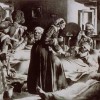“Nurse of the Mediterranean”, “Florence Nightingale”. These terms are no coincidence and were not invented by some nationalist spinmeister in an effort to boost our “pride” in our country. As Maltatoday picks up on public sentiment and reports that three Maltese patients were moved out of the ITU to make way for injured Libyan persons […]

